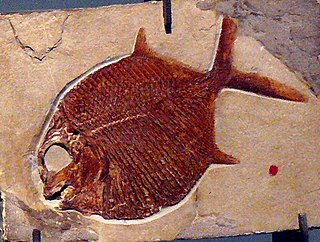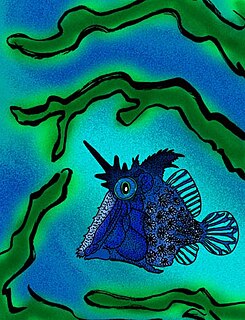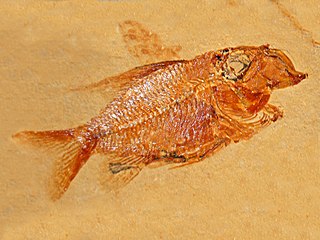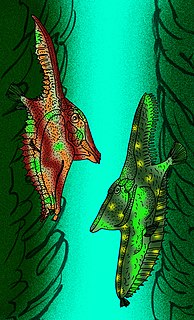
Pycnodontiformes is an extinct order of primarily marine bony fish. The group first appeared during the Late Triassic and disappeared during the Eocene. The group has been found in rock formations in Africa, Asia, Europe, North and South America. They were small to middle-sized fish, generally with laterally-compressed deep bodies, some with almost circular outlines, adapted for manuverability in reef-like environments. The group was morphologically diverse containing forms such the very short but deep Gebrayelichthyidae and the horned Ichthyoceros, both from the early Late Cretaceous of Lebanon. Most, but not all members of the groups had jaws with round and flattened teeth, well adapted to crush food items (durophagy), such as echinoderms, crustaceans and molluscs. Some pyncodontiformes developed piranha like teeth used for eating flesh. Most species inhabited shallow marine reef environments, while a handful of species lived in freshwater or brackish conditions. While rare during the Triassic and Early-Middle Jurassic, Pycnodontiformes became abundant and diverse during the Late Jurassic, remaining diverse until a burst of diversifiication at the beginning of the Late Cretaceous, after which they began to gradually decline, with a more sudden decline at the end of the Cretaceous due to the collapse of reef ecosystems, finally becoming extinct during the Eocene.

Beerichthys ingens is an extinct prehistoric bony fish that was a member of the Ypresian London Clay fauna of lower Eocene England.

Trewavasia carinata is an extinct pycnodontid fish in the family Coccodontidae that lived during the lower Cenomanian of what is now Lebanon. It had a large, forward-pointing horn-like spine between its eyes, and a massive stump-like spine emanating from the back of its head. T. carinata is closely related the genera Corusichthys and Hensodon, as well as Coccodus.

Coccodus is an extinct genus of extinct pycnodontid fish that lived during the lower Cenomanian. The various species had a pair of massive, curved spines emanating from the lower sides of the head, and one curved spine on the top of its head. Unlike most pycnodontids, Coccodus species had a comparatively long body, giving the living animals a superficial resemblance to a scaly chimaera.

Ichthyoceros spinosus is an extinct pycnodontid that lived during the lower Cenomanian of what is now Lebanon. I. spinosus had a triple, forward-pointing horn-like spine between its eyes, very similar to the single spine of Trewavasia, and a massive, multipointed spine emanating from the back of its head. It was originally placed in the family Coccodontidae, but then was transferred to "Trewavasiidae" with Trewavasia. Recently, it has been placed in Gladiopycnodontidae due to recent anatomical similarities with the various genera within that family, including Gladiopycnodus.
Ctenocephalichthys is an extinct genus of prehistoric ray-finned fish that lived during the Santonian.

Lissoberyx is an extinct genus of prehistoric ray-finned fish belongon to the family Trachichthyidae. Lissoberyx is a trachichthyid, but it shows more resemblance to the holocentrids than any other trachichthyid.
Oshunia is an extinct genus of prehistoric bony fish that lived during the Albian. Fossils of the genus were found in the Romualdo Formation of the Araripe Basin, northeastern Brazil. Other authors assign a Cenomanian age to the fish.
Mesoclupea showchangensis is an extinct ichthyodectiform ray-finned fish that lived in freshwater environments in what is now China during the Early Cretaceous epoch. It differs from its sister genus, Chuhsiungichthys, primarily by having a more posteriorly-placed dorsal fin.
Bobbichthys is an extinct genus of ray-finned fish that lived in what is now Chile during the Oxfordian stage of the Late Jurassic epoch.
Chongichthys is an extinct genus of prehistoric bony fish that lived during the Oxfordian stage of the Late Jurassic epoch. Fossils of the genus have been found in the Quebrada El Profeta of Chile.
Luisiella is an extinct genus of prehistoric bony fish that lived during the Kimmeridgian stage of the Late Jurassic epoch. Fossils of the genus have been found in either the Cañadón Calcáreo Formation or Cañadón Asfalto Formation in Chubut Province, Argentina.
Aetheolepis is an extinct genus of ray-finned fish which lived in freshwater environments in what is now Western Australia and New South Wales during the Jurassic period. It contains one species, A. mirabilis. Aetheolepis was previously thought to be an archaeomaenid, until a 2016 study instead recovered it as a member of the family Dapediidae. Like other dapediids, it had a deep, discoid-shaped body. Fossils of A. mirabilis have been found in the Talbragar River fossil beds of New South Wales and the Colalura Sandstone of Western Australia. It was named by Arthur Smith Woodward in 1865 along with other Talbragar fish.
Boreichthys is an extinct genus of prehistoric bony fish that lived during the Early Triassic epoch.
Opsithrissops is an extinct genus of prehistoric bony fish that lived during the Thanetian stage of the Paleocene epoch. It is a 120 centimetres (3.9 ft) fish in the family Osteoglossiformes which includes other bony-tongues such as the extant species of Arowana and Arapaima.
Gigantopterus is an extinct genus of prehistoric bony fish that lived during the Carnian stage of the Late Triassic epoch.
Caruichthys is an extinct genus of prehistoric bony fish that lived during the Anisian stage of the Middle Triassic epoch.
Kentuckia is an extinct genus of prehistoric bony fish.

Corusichthys megacephalus is an extinct pycnodontid that lived during the lower Cenomanian of what is now Lebanon. C. megacephalus is known from a 34 mm long fossil. It had plates arranged like a helmet around its head, and had a massive, triangular spine on its dorsal side. C. megacephalus is closely related the genera Trewavasia and Hensodon, as well as Coccodus.

Gebrayelichthyidae is a family of extinct pycnodontid fish, with a superficially shrimpfish-like appearance that lived during the lower Cenomanian.









